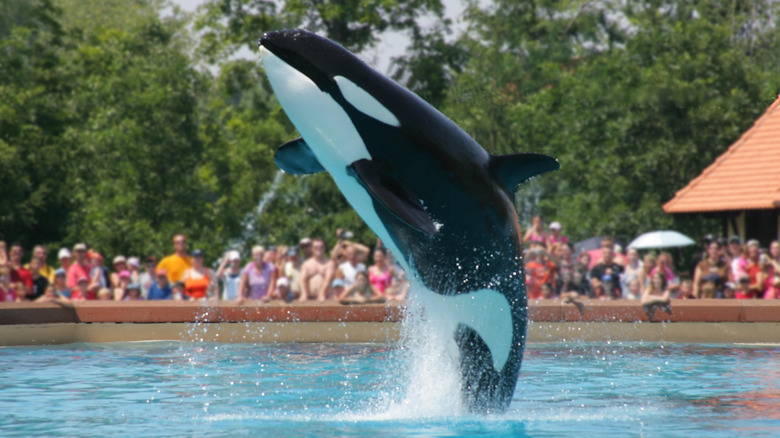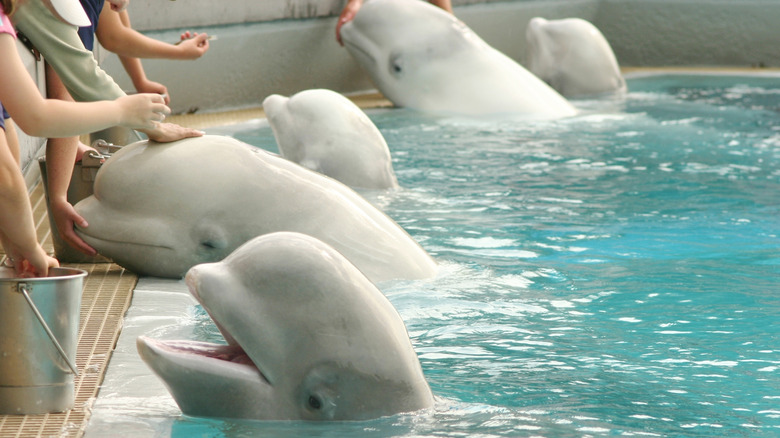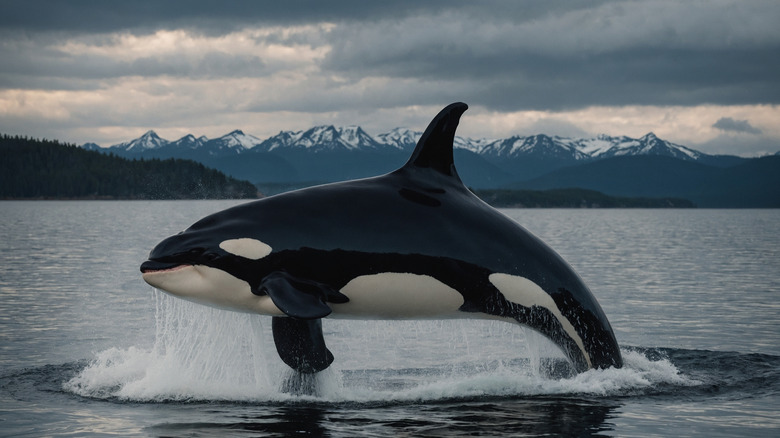Just Outside Of Niagara Falls Is An Abandoned Marine Theme Park With A Haunting Controversial Past
"Everyone looooooves Marineland!" This infectious jingle, which rang out over radio and TV from the early '90s onwards, is a prominent memory for many Canadians, particularly millennials and older generations. For those who passed through its turnstiles, Marineland is often remembered nostalgically: There were spectacular performances, where orcas breached majestically, twisting through the air with power and grace. And there were joyful moments, when seals planted gentle kisses on the cheeks of delighted children. It was one of the best things to do in Niagara Falls, Ontario — until it wasn't. Just like the dolphin's apparent smile, Marineland's upbeat image is a façade for a dark reality.
The aquarium-turned-mega-park had humble beginnings, a rags-to-riches immigrant success story that people loved. It was the brainchild of Slovenian John Holer, who came to the vineyard-rich region in 1957 in hopes of entering the winery business. After being fired from his job at a local vineyard, he turned his attention elsewhere. With two tanks and three sea lions, and charging 25 cents a head, in 1961, Holer began the aquatic empire that would become known as Marineland.
But, due to a myriad of controversial scandals that rocked the theme park, along with the death of the Holers, it now lies abandoned: Its food stalls are shuttered, rides are dismantled, and the surrounding greenery is overgrown. The attendees who once flocked to King Waldorf Stadium, the site of its highly anticipated marine shows, are gone. For its most recent operating season, the summer of 2024, it opened for a drastically scaled-back experience, with most of the restaurants, animal exhibits, and rides closed. In June 2025, the embattled park announced the sale of its rides. Currently, its website states in all caps, "Marineland is closed for the season!" Its fate — like that of the animals still kept inside — remains uncertain.
The truth behind Marineland
Not everyone loves Marineland: A veritable laundry list of alarming allegations has been made against it. According to former staffers, the water quality was so bad at one point that dolphins were shedding their skin while seals were losing their vision. The deer, kept on concrete grounds, developed sores and sometimes broke their legs. In 2024, the beleaguered park was also found guilty, under Ontario's animal cruelty laws, for its abuse and neglect of three young black bears. In the 2020 documentary "The Walrus and the Whistleblower," Phil Demers, one of Marineland's ex-trainers, asserts, "All training is based on food deprivation." He recounts how animals were expected to perform multiple shows daily and were kept hungry so they would remain obedient. Marineland sued Demers for $1.5 million (the case was later settled), and also filed lawsuits against several previous employees and the Toronto Star.
From 2019 to 2024, 18 belugas, a dolphin, and an orca whale died at the premises, along with numerous other marine and land animals. They were buried on-site in a mass grave until ordered to stop by the provincial government. Kiska, the last orca to die, earned the moniker "the loneliest whale in the world." She spent over 40 years in captivity, swimming endlessly in circles around her small tank, after being captured at the age of 3. For many of those years, Kiska was alone, as all five of her calves and her one companion died. Videos of the distressed killer whale slamming her face against the wall are a stark visual testament as to why Canada passed a law banning cetacean captivity. However, this legislative victory didn't feel very victorious — it didn't apply to animals already in captivity, and no Marineland orcas were ever released into the wild.
Alternatives for enjoying ethical animal interactions
Most still-active zoos and aquariums argue that they provide an invaluable educational experience, where visitors come away with increased knowledge about biodiversity and conservation. However, this claim hasn't been proven definitively. Captive animals don't have the same social skills, habits, or even "language" that their non-captive counterparts have — so how valuable is this experience in learning about the lives and behaviors of wild animals?
There are many better alternatives to visiting animals in cages and marine life in tanks. The best options for harm-free interactions are those where the animals are in their natural habitat, humans are kept at a distance, and there are no hands-on activities, guaranteed sightings, or tight confinement. These can include wildlife safaris, snorkeling or diving trips, and professionally-guided nature tours. In northern Manitoba, stay at Nanuk, a remote eco-lodge in the Canadian wilderness. You'll explore the Arctic tundra and photograph polar bears or cloud wolves on daily expeditions. To see marine creatures in their element, book an underwater excursion. Glide over vibrant corals and watch the many species that inhabit this fragile ecosystem, or head to the world's largest saltwater lagoon to see schools of majestic reef sharks patrolling the area. And if you dream of spotting the "Big Five" animals, then a safari is your best bet. Visit Lapalala Wilderness, an expansive South African reserve, where you'll sleep in a "sky bed" under the stars.
Yes, these options are decidedly pricier than the entrance fee to an amusement park. But if it's important for you to have a truly educational experience and memorable, authentic interactions with animals, then it's worth the cost. It's far better to have more expensive, mindful animal encounters than affordable ones where harm and cruelty are embedded into every element of the experience.


